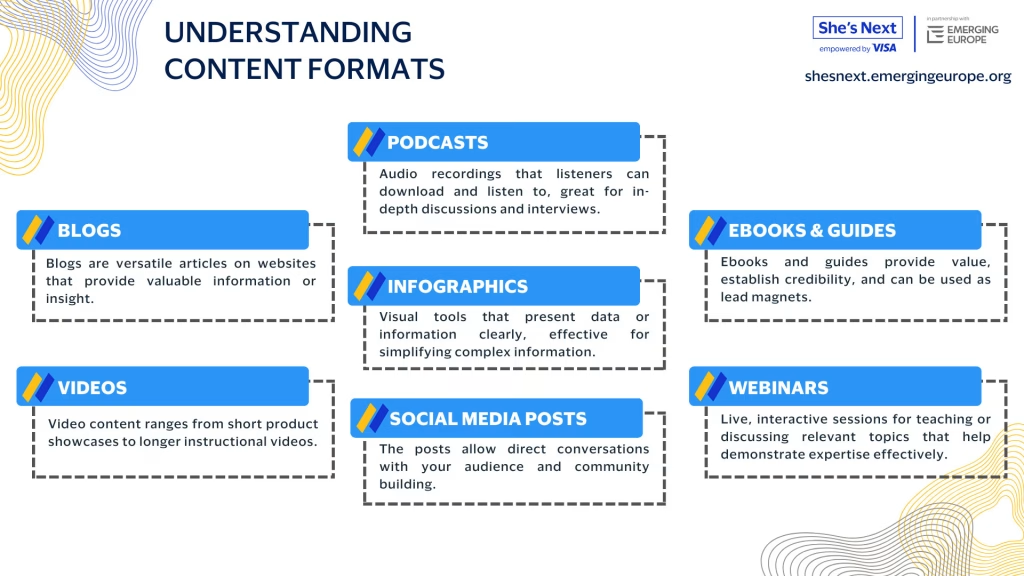
Selecting the Ideal Content Formats for Your Audience
Content marketing is a vital tool for connecting with customers and promoting your business online.
Understanding how to use different types of content can make a big difference in reaching and engaging your audience.
Understanding Different Content Formats
Let’s explore the most common content formats:
Blogs: Blogs are versatile articles on websites that provide valuable information or insight. They can help establish you as an expert in your field and improve your website’s visibility on search engines. Pros include building credibility and SEO benefits, while cons may involve the time and effort required for consistent writing.
Videos: Video content ranges from short product showcases to longer instructional videos. Videos are highly engaging and can convey emotion and personality effectively. Pros include high engagement levels, but cons may include production costs and potential technical challenges.
Podcasts: Audio recordings that listeners can download and listen to at their convenience. Podcasts are great for in-depth discussions and interviews. They cater to audiences who prefer auditory content over reading. Pros include building a loyal following, but cons may involve the need for regular content creation.
Infographics: Visual tools that present data or information clearly. Infographics are effective for simplifying complex information into shareable visuals. Pros include high shareability on social media, but cons may involve design expertise requirements.
Social Media Posts: Content created for various platforms like Facebook, Instagram, X/Twitter, and LinkedIn. These posts allow direct conversations with your audience and community building. Pros include real-time engagement, but cons may involve maintaining consistency across platforms.
Ebooks/Guides: In-depth written materials covering specific topics thoroughly. Ebooks and guides provide value, establish credibility, and can be used as lead magnets. Pros include lead generation, but cons may involve the time and resources needed for comprehensive content creation.
Webinars: Live, interactive sessions for teaching or discussing relevant topics. Webinars offer real-time engagement and can demonstrate expertise effectively. Pros include direct interaction with the audience, but cons may involve technical challenges and audience availability.
The Pros and Cons of Each Format
When deciding on the appropriate content format for your strategy, it’s essential to weigh the pros and cons of each option.
For instance, written content may be preferred by audiences who enjoy reading and can be cost-effective to produce, but it may not be as engaging as visual or interactive formats. On the other hand, video content can be highly engaging and shareable, but it often requires more resources and time to create.
By considering factors like audience preferences, available resources, and distribution channels, you can make an informed decision that aligns with your content goals and objectives.
Choosing the Best Formats for Your Audience and Goals
Align your content format with your business objectives and audience preferences. Consider whether your goal is brand awareness, lead generation, or thought leadership positioning when choosing the most suitable format.

Content Strategy
Creating a successful content strategy involves developing a comprehensive plan that integrates various content formats to achieve your goals effectively. To do this, it is crucial to understand your audience’s preferences and behaviours.
By identifying the most effective channels for distributing your content, you can maximize its reach and impact.
Here are 5 simple steps you can follow to get there:
Define Your Goals: Clearly outline what you want to achieve with your content strategy. Whether you want to increase brand awareness, grow website traffic, or generate leads, having clear goals will give direction to the process of content creation.
Know Your Audience: Conduct thorough research to understand your target audience’s demographics, interests, and online behaviour. With this in hand, you will be able to customise your content to resonate with your audience with the desired impact.
Choose the Right Content Formats: Experiment with different types of content such as blog posts, videos, infographics, and podcasts to see what resonates best with your audience. Diversifying your content formats can keep your strategy fresh and engaging.
Create a Content Calendar: Plan your content creation and distribution schedule by creating a content calendar. This will help you stay organised and ensure a consistent flow of content across your channels.
Measure and Analyse: Use analytics tools like Google Analytics, social media insights, and email marketing metrics to track the performance of your content. Analysing this data will provide valuable insights into what is working well and what needs improvement.
Budget and ease of use are key for entrepreneurs, who are often short of time and wearing multiple hats. Here are a few tools that can simplify content production and monitoring:
Google Analytics: Track website traffic, user behaviour, and conversions to measure the effectiveness of your content.
Hootsuite: Manage and schedule social media posts across multiple platforms to streamline your content distribution process.
Canva: Create visually appealing graphics and designs for your content without the need for graphic design skills.
Mailchimp: Design and send email campaigns to engage with your audience and drive traffic to your website.
BuzzSumo: Discover trending topics and analyse competitor content to inform your content strategy.
Track the performance of your content and use analytics to refine your approach. Adjust your strategy based on audience feedback and data insights to optimize your content marketing efforts effectively. Experiment with different content formats to determine what resonates best with your audience.
By analysing feedback and performance metrics, you can create a content marketing strategy that truly connects with your customers and drives business success.
New Free Courses — Made for Ambitious Women Entrepreneurs!
It’s time to grow smarter, adapt faster, and take your business global.
Explore two powerful courses available exclusively to She’s Next members:
The Reinvention Masterclass for Start-up Founders
Beyond Borders: Building for Global Success
Enroll today — it’s free!






Responses